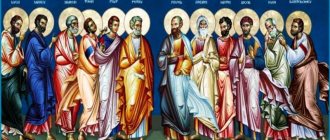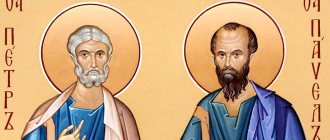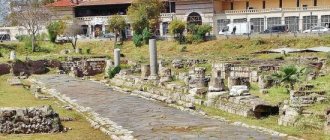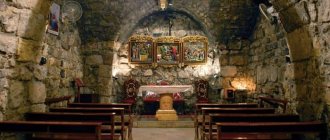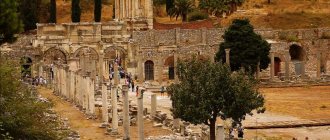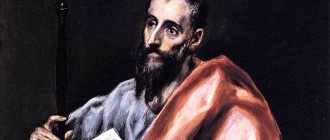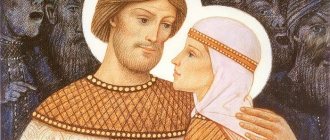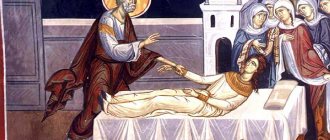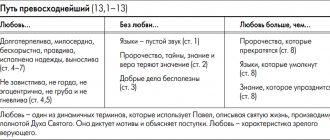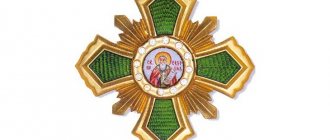The wondrous deeds of the Lord can be traced through the example of the life and miraculous conversion of the Holy Apostle Paul. A zealous persecutor of Christians in a short time turns to Christ and becomes a preacher of Christianity, and then even accepts martyrdom for his firm faith. What could be more wonderful? What more clearly testifies to the miracles of God than this short life devoted to serving Christ.
Saint Paul was not one of the twelve apostles and was not an apostle of the seventy, but he is called “the supreme one.” Why?
Origin of Paul
He was born in Cilicia, in the city of Tarsus, around the fifth - tenth year of our era. The exact date has not survived to this day. His name was Saul, most likely he was named after King Saul. His father was from the tribe of Benjamin, a true Pharisee. He also raised his son in the traditions of Pharisaism. He received Roman citizenship from his father. At that time, few people had it.
Saul's Latin name is Paul, which means "little one." Most likely, he had this meaning in mind when he called himself “the least of the apostles” in his letters.
From childhood, Saul studied Jewish law from Rabbi Gamaliel the Elder. He perfectly learned the Torah and its interpretation. In addition, Saul learned to make tents, which helped him later in life. If you remember his messages, he wrote that he provides himself with such a craft, and does not ask for alms.
It is not known whether Paul was married or remained a virgin. In his messages he hints that he is familiar with family life. This suggests that he was once married, maybe widowed. But legends call him a virgin along with the Apostle John the Theologian . It also became known from legends that his sisters, Zinaida and Philonila, became holy martyrs.
Saul was trained in rhetoric, philosophy, literature, and various languages. The techniques of ancient rhetoric are noticeably traced in his messages.
According to descriptions of that time, Saul was of average height, with fused eyebrows, bald and with a prominent nose.
Paul as the founder of Christian anti-Semitism
Due to his negative attitude towards Jewish religious law, Paul of Tarsus managed to become the main initiator of the separation of Christianity from Judaism and its transformation into a world religion. Christianity had to break ties with Jewish religious law precisely because many pagan proselytes were willing to observe only a few mitzvot. According to Paul, a pagan who converted to Christianity and kept the commandments is not a real Christian. The efforts of Paul of Tarsus to abolish the observance of the commandments bore fruit already in the 2nd century. Christians not only abandoned the observance of the ritual prescriptions of the Jewish religion, but also began to be prejudiced against the entire way of life of religious Jews. Although Paul himself did not require his Jewish followers to abandon the observance of mitzvot, their observance by Jews wishing to convert to Christianity was prohibited already in the mid-2nd century. This was also the position of the church in the Middle Ages.
The origins of Christian hostility to Judaism are based on the writings and decisions of Paul of Tarsus. Although Paul generally demonstrated love for the Jewish people and faith in their future salvation, in 1 Thessalonians he directly accused the Jews of “deicide” (1 Thess. 2:15-16). Paul of Tarsus's positive remarks about the Jews did not influence the church's attitude toward the Jews in the Middle Ages and the Reformation.
Paul's position on the issue of observance of the precepts of the Jewish religion by pagan proselytes aroused the protest of many members of the Jerusalem Christian community, including the Apostle Peter (see above). The matter did not reach the point of open schism, since the poor Jerusalem community was interested in the donations of fellow believers and in the spread of the new religion among the pagans, but those groups of Jewish Christians who did not join the emerging Christian church were characterized by hatred of Paul of Tarsus and his cause.
Paul's radical condemnation of the religious law could not be fully accepted by later Christianity, since it led to antinomianism, to the denial of all religious obligations. Paul's words were taken up and largely falsified by the Gnostic Marcion (who was credited by a number of historians with the authorship of Paul's letters from Tarsus), an open enemy of Judaism, the Jewish people and their God.
Paul of Tarsus played a crucial role in the formation of Christian dogma: he promoted the deification of Jesus, referring to him those biblical verses that talk about God, and in every possible way emphasized the idea of salvation through the death of Jesus and his resurrection from the dead. The Church adopted and strengthened Paul's idea of original sin, but did not accept the idea of predestination, associated with the idea of absolute, unconditional Divine grace.
The church fathers before Augustine recognized the idea of free will and the importance of good works in man's salvation. Augustine rediscovered Paul's teaching about the predestination of Divine grace and the ineradicability of human sinfulness; After the condemnation of the heresy of Pelagius (431), the Catholic Church practically accepted the teachings of Paul of Tarsus. Disputes around this doctrine resumed in the 9th century, but soon died out. Only M. Luther and J. Calvin revived - each in his own way - some of the most important elements of Paul's teaching (Paulinism). To this day, the debate continues between Christian theologians about the positive and negative influence of Paul on the face of Christianity. Paulinism influenced the so-called dialectical theology.
Orthodoxy considers Paul of Tarsus one of the two (together with the Apostle Peter) founders of the Christian church.
Persecution of Christians
In those days, persecution of Christians by the Pharisees was common. This was due to Christian public preaching, which was incompatible with Orthodox Judaism. Firstly, death on the cross was considered the most shameful for Jews. This is how they dealt with especially dangerous criminals. And the Jews were waiting for the Messiah, as the king of Israel, who was to come in all pomp and majesty.
Secondly, many Christian sermons denounced the cult of the Israelite temple. This did not suit the Pharisees; it even offended their religious feelings.
Saul, as a zealous Pharisee, before his miraculous conversion, was a participant in the persecution of Christians and even took part in some reprisals against them. In particular, the book of the Acts of the Apostles described in detail how, during the execution of the holy protomartyr Stephen, Saul guarded the outer garments of his brothers who were stoning the martyr.
Other punishments for Christians were: scourging (forty blows in five rounds) and imprisonment. But stoning was the most cruel execution. Even watching such a procedure was very difficult; the spectacle is not for the faint of heart. And Saul calmly watched this, guarding the clothes of the Pharisees’ executioners. Most likely, his heart was very hardened then.
Childhood and youth
The future inspired educator was born at the beginning of the 1st century in the large trade and cultural center of the province of Cilicia - the city of Tarsus (Asia Minor). His relatives were wealthy and zealous Jews, hereditary citizens of Rome, which was an exceptional social privilege. According to family legend, they came from the tribe of Benjamin, like the first Jewish king Saul, in whose honor the boy received his name.
Saul
After initial home schooling, the gifted young man became the best among the students of the authoritative theologian Gamaliel at the Rabbinical Academy in Jerusalem. By the age of twenty, he had developed into an erudite personality - he thoroughly studied the Pentateuch, perfectly mastered Greek, Biblical Hebrew, Latin, was well versed in oratory, in the intricacies of philosophy, Roman law, and quoted Greek poets. As was customary among the teachers of the law of that time, he also mastered a simple craft - making tents for the Feast of Tabernacles, in order to be able to earn a living by his own labor.
"The Stone Stoneing of St. Stephen", Rembrandt
The young man believed with all his heart in the coming of the Savior, imagining him, like many of his fellow tribesmen, in the image of a powerful earthly ruler. The carpenter from Nazareth, indifferent to the temptations of the material world, did not live up to these expectations. Therefore, Saul considered him an impostor and a threat to Judaism. By order of the Sanhedrin, the ardent zealot of the Law witnessed the stoning of the first martyr Stephen - he guarded the clothes of the tormentors. Then Saul received the official right to participate in religious reprisals against adherents of the teachings of Christ.
Conversion to Christ
And Christ was able to turn such a cruel and impenetrable person to Himself and melt his iron heart. In the Acts of the Apostles this miracle is described in great detail.
Saul was then about thirty years old, and he was walking along the road to Damascus. Suddenly, unexpectedly, a light came down from the sky and blinded him. Then he heard a voice reproaching him: “Saul, why are you persecuting Me?!” It was probably the voice of Christ Himself. After all, when he took part in the persecution of Christians, tormented them, he tortured Christ Himself, according to the Gospel word: “if you did it to one of the least of these, you did it to Me.”
The rest of the people did not hear this voice. After this miraculous appearance, Saul became blind and remained in this state for three whole days. He was brought to Damascus, where he was baptized by the Apostle Ananias. After baptism, Saul's sight returned.
In such a miraculous way, the ardent persecutor of Christians became a Christian himself in just three days. From then on his name became “Paul”.
Life
Apostle Paul From the Deesis rite School or art. center: Byzantium 1387–1395 149 × 97 cm State Tretyakov Gallery, Moscow, Russia Inv. 12752 The icon is part of the Vysotsky half-figure Deesis rank.
Origin
The future apostle was born in the 1st century in the city of Tarsus in Cilicia. Now this is the territory of Turkey. The years of the apostle’s life are 5-67. Saul—that’s what his parents called him—grew up in a deeply religious Jewish family that followed the strict canons of Pharisaic piety. In the best sense of the word.
Apparently, Saul's family was not very poor, since the future apostle was a citizen of the Roman Empire. But few people in Palestine received such an honor. The subjects of Rome had a lot of privileges. One of them was that only Caesar could judge them if they committed any crime. And in the future this played into Pavel’s hands.
Useful materials
Saul's parents dreamed of seeing him as a rabbi and sent him to study in Jerusalem, with the most famous teacher and scholar at that time, Rabban Gamaliel ben Shimon ha-Zaken. patriarch of the Pharisaic party. It is worth noting that despite his high rank, Gamaliel (in Christianity - Gamaliel) adhered to very free views and more than once called on the Sanhedrin not to persecute the followers of Christ.
Note that Saul was very successful in the sciences. He knew the Torah very well - the holy book of the Jews, as well as its interpretations. In addition, the young man mastered the art of sewing tents, and in the future this allowed the apostle to earn a living.
Apostle Paul From the Deesis rite School or art. center: Moscow Last quarter of the 14th century. 210 × 117 cm Annunciation Cathedral of the Moscow Kremlin, Moscow, Russia Inv. 3238 sob/zh-1391 The icon is in the Deesis rank of the cathedral.
Persecution of Christians
Unlike his great liberal teacher, Saul held very different views. Growing up in an Orthodox Jewish family, he was sure that a person who was subjected to crucifixion, the most shameful execution, could not be the Messiah. A person who destroyed all foundations and directly turned to God, bypassing all temple rituals and not recognizing the primacy of Jerusalem and the Temple, cannot be the son of God.
He revered the Mosaic Law in the strictest manner and, while still very young, became famous for his cruel persecution of Christians. Saul was present at the execution of the first martyr Stephen, although, due to his age, he did not directly participate in it.
But a year later, having reached adulthood (in Palestine in those years it was the age of 13), he with all his zeal threw stones at the followers of Christ and subjected them to torture. And soon, with the permission of the Sanhedrin, Saul left Palestine for Damascus. All with the same mission - to cleanse the world of followers of the Crucified One.
Appeal
But the Lord’s plan is known only to Him. Saul was able to see this for himself. On the road to Damascus, something happened that turned him from an ardent persecutor of Christians into the greatest teacher, bringing the world the news of the risen Christ.
It happened on a hot sunny day. Saul and his companions were walking along the road from Jerusalem to Damascus. Suddenly his eyes were struck by a bright light. Out of fear, the blind young man fell straight into the road dust and suddenly heard a voice:
“Saul, Saul! Why are you persecuting me? “Who are you?” the persecutor of Christians barely whispered. “I am Jesus whom you persecute!” - sounded from heaven, - Go to Damascus, there you will find out what to do!
Saul's fellow travelers heard the same thing, but they did not see the bright light - only Saul was blind. Shocked to the core, they picked up the young man and went to where the Lord told them. In Damascus, Saul was brought to a Christian named Ananias.
Over the course of three days, he absorbed everything that he could tell him about Christ, and as a man who had already deeply believed in the Savior, he accepted Holy Baptism. And, oh, miracle! Only after immersing himself in the water did Saul receive his sight! Since then, a new life began - the greatest Christian preacher and teacher.
Apostle Paul From the Deesis rite School or art. center: Tver First half of the 15th century. 111 × 43 cm State Tretyakov Gallery, Moscow, Russia Inv. 15056 The icon belongs to the Tver Deesis rite from the collection of A.I. Anisimov.
Service (1, 2, 3 mission trips)
The Apostle Paul called himself “Apostle of the Gentiles” (that is, of the Gentiles). And not by chance. Soon after receiving Holy Baptism, the former persecutor of Christians himself became persecuted and persecuted. Saul began his work and preaching about Christ among the Arabian Jews, preaching in synagogues.
However, this state of affairs did not suit either the Jews themselves or the ruler Aretas IV Philopatrix. They saw Saul's preaching as undermining the foundations of faith, and the preacher was put on the wanted list. For safety, Saul fled to Jerusalem.
However, even there he was not received with open arms. If he was driven out of Damascus by the rage of his former co-religionists, then in Jerusalem he was met with the distrust of his brothers in Christ. They could not accept their former persecutor. The Apostle Barnabas came to the rescue of Saul - he took him under his protection.
After leaving Jerusalem, Saul went to his hometown, and from there to Antioch. Where, in fact, his first missionary journey began, which lasted 6 years, from 45 to 51 years old. He set off on the journey together with his companion, the Apostle Barnabas.
First they returned to Jerusalem, and from there they went to Crete. An attempt to preach among the Jews did not bring the desired result. Moreover, Saul, and from that time on Paul, were subjected to severe persecution and beatings by the Jews.
One day, after stoning him, they left him for dead. But the Lord had his own plans. The preacher survived. And he went to preach to the pagan peoples. While traveling, Paul and Barnabas founded communities in several large settlements, including Iconium, Derbe, Lystra, and Antioch of Pisidia. In 51, with the participation of Paul, at the first council in Jerusalem, it was decided that newly converted brothers could be baptized without first observing the Mosaic rites.
In 51, Pavel sets off on his second journey. First he visited churches in Asia Minor, and after that he decided to go preaching to Europe. He founded several Christian communities in Macedonia, met with the evangelist Luke and went to Greece to preach. After preaching in Athens, he went to Corinth, where he also founded a new Church. For more than a year, Pavel lived in the house of his new friends, the spouses Priscilla and Aquila. Leaving Corinth, Paul went to Antioch, passing along the way to Ephesus, Caesarea and Jerusalem.
In 56, Paul went on the road again. This journey was the shortest of all - until the age of 58. As always, Paul first visited the communities he had founded, which had grown markedly over these few years, and then went to Ephesus. There, by the way, one of the most famous works of the apostle was written - 1st Epistle to the Corinthians, as well as the Epistle to the Galatians.
However, not everyone liked the missionary's sermons. A certain silversmith named Dmitry rebelled against the preacher, and Paul was forced to leave Ephesus and go to Jerusalem, while visiting Macedonia.
Imprisonment, death
However, Jerusalem also met Paul very unfriendly. A rebellion arose against him, as a result of which the preacher was captured and arrested. This is where citizenship of the Roman Empire came in handy. After spending two years in prison, Paul wished to go to Rome. They could not deny him this right.
But the ship on which Paul set off was shipwrecked near Malta. So Paul arrived in the “Eternal City” only in 62. I must say that he felt very free there. The authorities turned a blind eye to his missionary activities, and Paul preached in the streets completely freely. Here, in Rome, several of his famous works were written - the epistle to Philemon, to the Ephesians and Colossians.
There are quite contradictory information about how Paul’s fate developed later. Some researchers claim that he was executed in 64, just at the time when Nero's persecution of Christians began.
However, from other sources, including from the letters of the Apostle Paul, it becomes clear that after some time he again went to the east, staying in the churches he founded and ordaining his disciple Timothy as Bishop of Ephesus. Then, having met the Apostle Peter, he walked with him all over Italy and fulfilled his old dream - he brought the news of Christ to Spain.
Returning to the “eternal city,” Paul was again imprisoned, from which he did not leave until his execution. True, legends have been preserved that the apostle taught during these years even at the court of Nero.
The execution of the Apostle Paul took place in 67. As a subject of Caesar, his head was cut off. According to legend, in the places where the apostle’s head hit the ground three times, 3 springs gurgled. Now on this site there is a monastery at the Three Springs.
Apostle Paul From the Deesis rite School or art. center: Tver End of the 15th century. Evseeva, Kochetkov, Sergeev 1974: XV century. Saltykov 1981: Second half of the 15th century. Sophia Wisdom of God 2000: Last quarter of the 15th century. 84 × 59 cm Central Museum of Ancient Russian Culture and Art named after. Andrey Rublev, Moscow, Russia Inv. KP 994 From the Deesis rite of the late 15th century. from Vesyegonsky district of Tver region.
Beginning of Paul's sermons
Immediately after his baptism, Paul went to his first Christian sermon. It was for the inhabitants of Arabia (the Jews also lived there). After this, he returned to Damascus, where King Aretas pursued him.
Paul then goes to Jerusalem. But the residents of this city remembered Paul as a furious persecutor of Christians, and here he addresses everyone with a Christian sermon. They could not believe such a rapid change in his outlook, so they were afraid of him. The apostles especially did not accept him. Only the assurance of the Apostle Barnabas helped correct the matter.
Then Paul went to his hometown, from where he and Barnabas went to Antioch. From there he went on his first apostolic journey around the world.
Because of the controversy over circumcision, the first apostolic council was convened in Jerusalem. On it, Paul put forward the version that there is no need for Christians to undergo circumcision. The other apostles also accepted his point of view. But when he came to Antioch, he had disputes with the Apostle Peter about this.
Biography
The Apostle Paul did not communicate with Jesus Christ during his earthly life; he was not part of the Savior’s closest circle of disciples, nor was he one of the seventy preachers. The saint's biography contains dark spots and incomprehensible events. Paul was initially an ardent opponent of any teaching, a persecutor of followers of the faith, but the texts he wrote formed the basis of the foundation of New Testament theological thought, and the apostle himself turned into one of the most revered Christian saints.
Paul's second and third apostolic journeys
Paul went on his second journey with the apostle Silas. In the city of Lystra he met Timothy. He becomes Paul's student, and then they travel together. The path lay to Europe. They visited Philippi, where Paul was briefly detained. Then we went to Thessalonica. In Athens, Paul met Dionysius the Areopagite. Then they went to Corinth, where they met a pious couple - Priscilla and Aquila. Then they returned to Jerusalem.
The third journey began in Ephesus, where Paul wrote his first letter to the Corinthians and Galatians . He then went to Macedonia, where the second letter to the Corinthians .
Then Paul visited Hellas, Philippi, Troas and Tyre. The Epistle to the Romans was written here .
Paul's trial
In Jerusalem, the accusation was raised against him that he allowed the pagans to go to Solomon's temple. At the trial in the Sanhedrin, where Paul was brought, a dispute took place between the Sadducees and the Pharisees. Due to his Roman citizenship, Paul could not be executed. He was sent to the procurator Felix for trial, who left him in prison. The procurator sent him to Italy to the emperor for trial.
Paul is then sent away on a ship as a prisoner. But near the island of Melit the ship is wrecked. Then he goes to Syracuse and Rome. Here he lived for two years and wrote many of his messages. In them he lists his sufferings and ordeals that he had to endure for Christ during his sermons. They also describe miracles, such as the opening by an angel of the prison where Paul and others were.
The essence of the ministry of the apostles
The apostles were not just preachers of a new faith, but also guardians of the Word of God. The Apostles compiled the Gospel and the Epistles of the Apostles, the entire New Testament corpus of texts. It is in it that the doctrinal theses are explained and the moral principles of the life of a Christian are given. They organized the Church of Christ and spread Christian doctrine among non-Jewish peoples. By their example of ascetic life, the apostles are an example of how to love your neighbor and honor God.
The essence of apostolic ministry is to convey to people the Good News, the faith of Christ. Their whole life was devoted to preaching.
How many apostles were there? In addition to the closest 12 apostles and the Apostle Paul, 70 more apostles were chosen from among the followers of Jesus Christ. But they were not constantly with the Savior and were not eyewitnesses of His life. Their names are not mentioned in the Gospel; a complete list was compiled in the 5th – 6th centuries.
Fourth Apostolic Journey
After this, Paul was released and went on his fourth apostolic journey. He visited the churches he had founded earlier. Titus was ordained bishop by Paul on the island of Crete. He then ordained Timothy as Bishop of Ephesus. In Corinth he met Peter and went with him to Rome.
Paul then visited Spain, after which he returned to Rome, where he was captured. From prison he wrote his second letter to Timothy .
last years of life
While imprisoned in Rome, Paul was sentenced to death. But as a Roman citizen he could not be crucified. So they cut off his head with a sword. This happened under Nero in the sixties. The exact date of his death is unknown.
A memorial sign was erected at the site of his burial. Later, the temple of San Paolo fuori le Mura was built on this site.
Catholics celebrate his memory on June 29th. Orthodox Christians celebrate July 12th according to the Julian calendar. Since the two apostles, Peter and Paul, served the cause of enlightenment most of all, they are called the “highest apostles.”
Discovery of relics
In 2009, the Pope issued a decree to examine the relics that were in the temple of San Paolo Fuori le Mura. But the stone of the sarcophagus turned out to be too thick. Therefore, a special probe was inserted into it through the hole, through which the remains were examined. Bones and parts of preserved tissue were discovered.
After the research is completed, perhaps the sarcophagus with the relics will be opened for worship in Rome (if the examples of remains found match the description of the apostle’s appearance).

